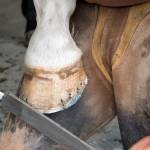Hoof Rehabilitation: Getting Your Horse Back on Its Feet

Imagine this scenario. You purchased a horse months ago, shipped it across the country, and have been enjoying all sorts of outings during the spring and summer—clinics, trail rides, a few horse shows, even a parade. Despite being the perfect mount for you in terms of disposition, you’ve run into a snag: his once-strong hooves have deteriorated. Now, all four are weak and crumbly, frustrating you and your farrier. Strong-willed, you’ve decided to press on, full-throttle, to find a solution. But where do you start?
Try this four-pronged approach to getting your horse’s hooves in order.
Assess nutritional status. When healthy horses with normal or low metabolism have access to sufficient calories, they maintain their weight easily, sometimes so effortlessly they become overweight. Offering sufficient calories to maintain weight is not the same as offering optimal nutrition. Because optimal nutrition is the cornerstone of many physiological processes, including healthy hoof growth, consider reviewing your horse’s diet with a professional nutritionist. By factoring in every component of a horse’s diet—forages, concentrates, supplements—a nutritionist can expose any deficiencies or excesses and suggest ways to correct them. Forage-based diets, for instance, are sometimes deficient in key nutrients, making the provision of a ration balancer or a vitamin and mineral supplement necessary.
Once any deficiencies in the diet have been addressed, give the hooves two to three months to respond, and then inspect the new growth that erupts from the coronary band. Is the texture significantly different than the hoof wall below it? If so, you could be on the right track with the dietary changes. If not, consider adding a scientifically formulated hoof supplement to your horse’s ration. Many horses respond positively to supplemental biotin and other ingredients typically found in high-quality hoof supplements, such as methionine, organic zinc, and iodine.
Be attentive with daily care, and be mindful of changes in hooves and way of going. Picking out hooves is an oft-neglected aspect of horsemanship, even for those horse owners that regularly schedule trims and resets. Hooves benefit from regular and thorough inspection. Examine each hoof carefully and look for general changes in shape; palpate the frog, digital cushion, and other structures to reveal any changes in texture or integrity; be aware of unusual odors that may signal thrush or other infection. Study the exterior of the hooves, noting any cracking or unusual wear. Snap photos of the hooves to have a frame of reference, especially when dealing with cracks or large chips. Moreover, take note when the horse objects to certain footing. Is he comfortable on grass but short-strided on pavement? Ouchy on stones but even and cadenced on packed clay? Report unusual findings to your farrier.
Schedule an in-depth consultation with a farrier. If you’ve used the same farrier since the horse’s arrival, he has probably observed changes to the horse’s hooves with each appointment. Be fearless when quizzing your farrier about your horse’s feet. Ask why textural changes and subsequent crumbling happen. Work with the farrier to create a gameplan for improvement. This may include paying special attention to the provision of dry, clean bedding when stalled, avoiding turnout when footing is wet or muddy, or keeping baths to a minimum. Or it might mean a change in trimming or shoeing schedule or technique. Stick to the gameplan to give your horse the best chance of recovery.
Seek a second opinion or a specialist. Ultimately, your farrier wants what’s best for your horse. So, if the two of you cannot find an answer to the problem, consider seeking a second opinion. Farriers and veterinarians who specialize in hoof care come to the profession from varied backgrounds and experiences. One farrier’s Rubik’s cube is another farrier’s tic-tac-toe. Find the farrier that has dealt successfully with similar problems and ask for a consultation.








